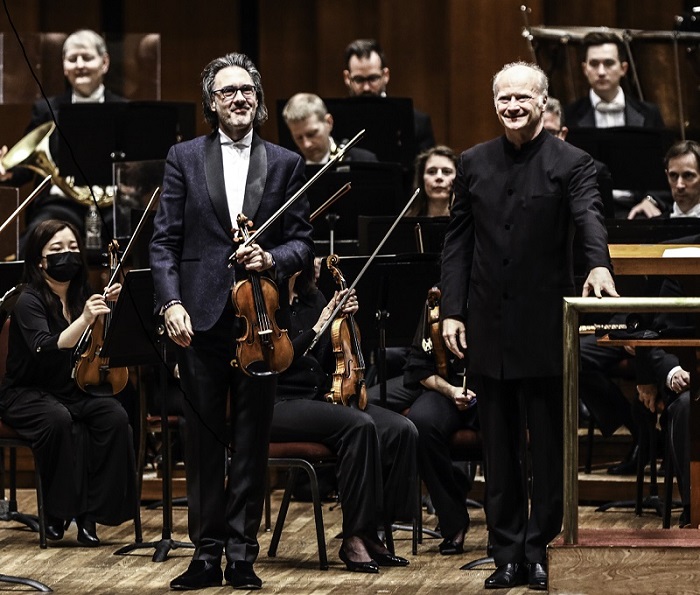Brutal Shostakovich, vital Bruckner from Kavakos, Noseda and NSO

Leonidas Kavakos, shown with his violin, the “Willemotte” Stradivarius, performed with the National Symphony Orchestra and Gianandrea Noseda Thursday night. Photo: Jati Lindsay
The National Symphony Orchestra’s program this week combined two welcome firsts. On Thursday night, the Kennedy Center Concert Hall saw the return of violinist Leonidas Kavakos, playing in Washington for the first time with his new violin, the magnificent “Willemotte” Stradivarius. After intermission, Gianandrea Noseda conducted Bruckner for the first time during his NSO tenure, choosing to begin with the enigmatic Sixth Symphony.
Kavakos acquired his new Strad in 2017, although he had wanted to own it since the 1990s. Since the Greek violinist last played here in 2016, with the Bavarian Radio Symphony Orchestra, this solo turn in Shostakovich’s Violin Concerto No. 1 was his first local performance with the “Willemotte,” made by the 90-year-old Antonio Stradivari in 1734. The combination, planned for 2021 and canceled by the coronavirus shutdowns, was well worth the wait.
Shostakovich completed this concerto in 1948, but it would not be performed or published, because of the composer’s denunciation by the Soviet authorities, until after the death of Joseph Stalin in 1953. Laurel Fay has documented the extent of the public humiliation Shostakovich endured, far beyond the loss of his teaching positions. Even his 10-year-old son was forced “to vilify his father during a music school exam.” Knuckling under, Shostakovich went on to state publicly, “I will work ever more diligently on the musical embodiment of images of the heroic Russian people.”
Kavakos called forth the Strad’s dark undercurrents of tone in the somber opening Nocturne movement, with smoldering intensity amid Shostakovich’s murky lines for tuba and contrabassoon. The violin’s higher register gleamed, softened by the use of a mute at times and answered by pinged notes from celesta and harp and whooshes of soft drums.
The Scherzo, by contrast, brayed and sneered with black humor, the tutti blasts surmounted by hammered xylophone like a crazy carnival ride one desperately wanted to escape. Kavakos pressed forward maniacally, taking daring chances at every turn, and the instrument responded with energy and precision. Only the Passacaglia seemed a little off the mark, with an impatient sense of tempo from Kavakos undermining the piece’s potential stateliness.
Few musicians can hold attention so vividly during the four-minute cadenza that leads to the closing Burlesca movement. Kavakos’s high soft notes glistened, followed by beautifully drilled double-stops and punctuated with perfectly accent chords. Triplets and sixteenth notes flowed effortlessly, with that perverse Scherzo theme breaking through at times, and at others obscured by chords struck across all four strings. Noseda’s careful gestures kept the ensuing, raucous galloping Finale in line, even bringing out some appearances of the Passacaglia theme.
The Sixth Symphony was a bold choice for Noseda’s first Bruckner, heard in this concert in the edition by Leopold Nowak. The first movement opened with a suitably majestic pacing, the cellos and horns trading the first theme back and forth, unusual for its chromatic shading, an element of harmonic color that percolates throughout the symphony. Noseda did especially well at shepherding delicate playing to assure powerful dynamic contrasts, heightening the impact of the full complement of brass, whose power resonated impressively.
The strings produced luxuriant sound in the extravagantly long slow movement, especially the violin section, whose sound has been growing more unified under Noseda. Violins and celli soared against one another especially in the movement’s second theme, a love song of tender yearning. Noseda could have gone with a much slower tempo, a choice that often pays dividends in Bruckner’s slow movements, above all in this movement’s third theme, which should sound more like a solemn funeral march.
Likewise, Noseda pushed the Scherzo to the overly fast side, seemingly not observing the composer’s tempo marking (“Nicht schnell”). The results, however, were quite thrilling, building up to furious tutti climaxes at the end of each section. Noseda gave a slow, smooth finish to the Trio, with extremely light pizzicato strings prompting boisterous thunder in response from the horn section. If anything, the repeat of the Scherzo section seemed more at ease and cohesive than the initial statement.
The Finale had a brooding quality initially, with tense pizzicati from the cellos and double basses. Blazing brass drove the movement towards more intense climaxes, but again with a rapid pulse that seemed not to take Bruckner’s tempo marking (“Bewegt, doch nicht zu schnell”) fully into account. Noseda’s interpretation bulldozed over the movement’s soft second theme: at a slower tempo, Bruckner’s allusion to the opening bars of the “Liebestod” from Wagner’s Tristan und Isolde stands out more clearly.
On the other hand, Noseda’s interpretation made the exultant conclusion very exciting, as the prevailing tonality of A minor finally resolved to A major in a brass-fueled sonic explosion. One hopes that Bruckner becomes Noseda’s next symphonic focus in the years to come.
The program will be repeated 8 p.m. Friday and Saturday. kennedy-center.org

Posted Jan 20, 2023 at 9:40 pm by robert reilly
I couldn’t agree more about Kavakos’ brilliant playing or Noseda’s and the NSO’s superb accompaniment.
The Bruckner broke the speed limit. Yes, the playing was exciting but at Bruckner’s expense. I missed the sense of majesty and the spiritual penumbra that conductors like Gunter Wand brought to this music.